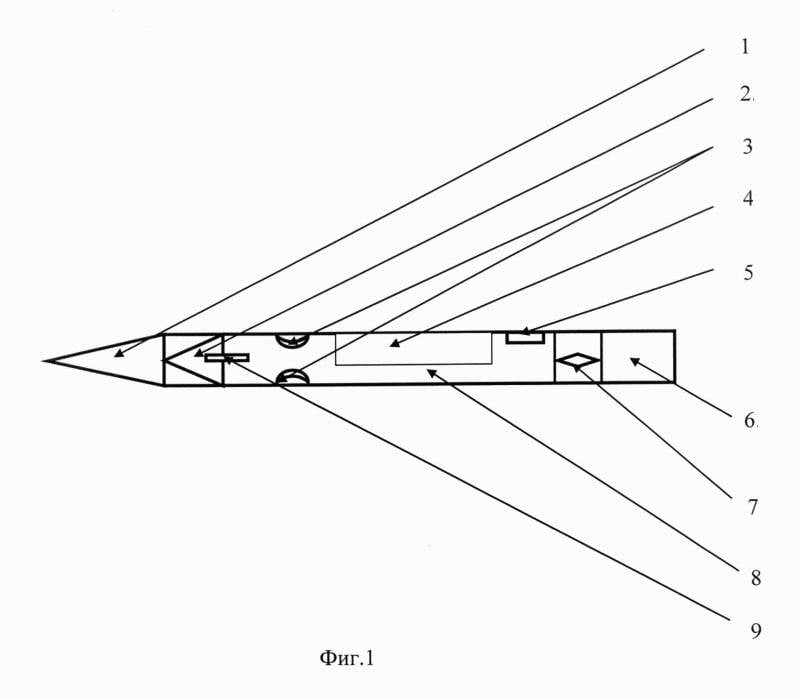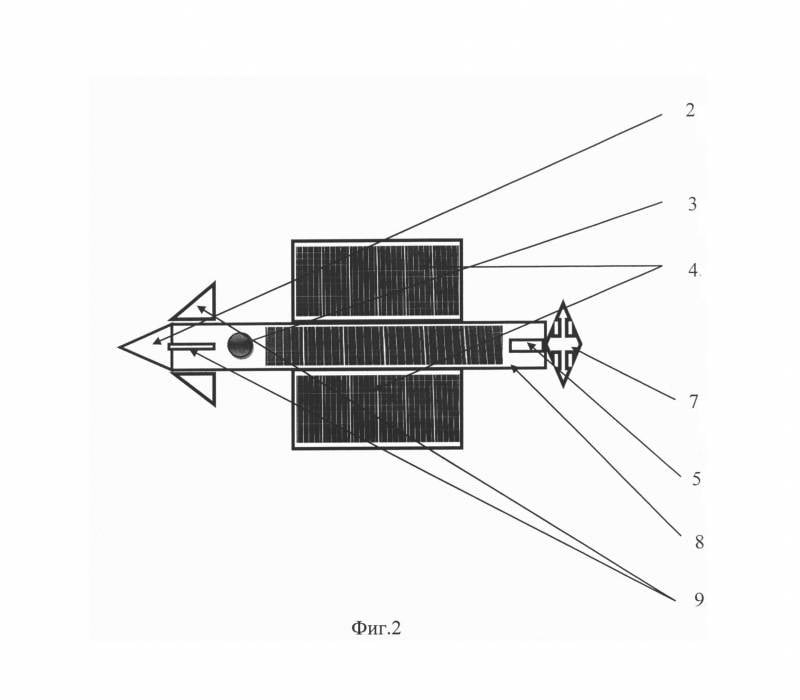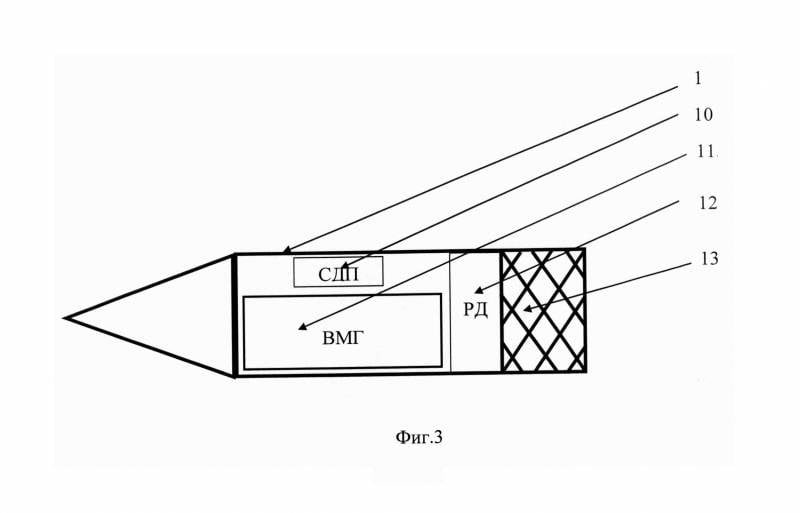The concept of an UAV with electromagnetic weapons from the Moscow Border Institute of the FSB

UAV in folded position, side view. 1 - ammunition; 2 - UAV head fairing; 3 - retractable optical means; 4 - folded wing; 5 - hatch of the parachute system; 6 - starting engine; 7 - stabilizer; 8 - fuselage; 9 - rudders
To combat unmanned aerial vehicles and electronic systems of the enemy, a wide range of means with different principles of operation is proposed. An interesting variant of the suppression and destruction of air targets was recently proposed by specialists from the Moscow Border Institute of the FSB. They have developed and patented a special drone with electromagnetic weapons.
A forward-looking concept
A new version of a special UAV is described in patent No. 2787694 "Unmanned aerial vehicle for destroying enemy electronic equipment." The authors of the invention are A.Yu. Berdnikov and S.N. Kukankov. The patent holder is the Moscow Border Institute of the FSB of Russia. The application for a patent was filed in August 2022. The date of registration of the invention is January 11, 2023.
The essence of the invention is quite simple. To combat unmanned aerial targets and ground electronic systems, it is proposed to use a UAV of an original design, armed with an electromagnetic pulse generator ammunition. In the description of the invention, similar systems of the past are recalled, which show the fundamental possibility of manufacturing and using EMRweapons.
The patent provides a general description of the design dronecarrier and its ammunition. Also attached are schematic images of these products, showing their main features.
The development organization received a patent, but the status of the project is unknown. Perhaps everything was limited only to the development of a general concept. However, it cannot be ruled out that a real UAV has already been developed on its basis, and in the foreseeable future it will become known about its testing or even its implementation in the troops or law enforcement agencies.
Unmanned platform
The concept project proposes the use of a specially designed UAV, initially capable of carrying a special payload. The appearance and technical features of such an air platform are determined by the specific role and ammunition used. However, nothing fundamentally excludes the use of another carrier drone.
The diagrams for the patent show an aircraft of normal aerodynamic configuration with a cylindrical fuselage of high elongation and a conical nose cone. In the central part of the fuselage, a medium-sized rectangular wing of small elongation was placed. In the tail - plumage with rudders. The wing should be made of flexible material; plumage extends from the fuselage.
According to the patent, a special UAV should be delivered in a transport and launch container with folded planes. This will simplify the transportation and start-up of the product in all operating conditions. In connection with the use of TPK, the drone needs a separate starting engine, which is reset after the initial acceleration. In addition, a parachute system is provided for a safe return.

View from above. Solar panels shown in black
The UAV must be fully electric. On board it is proposed to place a battery of sufficient capacity. The top surface can be used to install solar panels. The flight is carried out by an electric motor with a pusher propeller.
For observation in flight, two sets of optical means are provided, top and bottom on the fuselage. In connection with the use of TPK, optical stations must be retractable. It is also necessary to provide a permanent connection with the video signal transmission to the operator.
Dimensions, weight and performance characteristics of such a UAV are not given. They are to be determined at the development stage of a real project, taking into account existing needs and technical capabilities. In general, the device must be able to fly over a considerable range and long-term duty in a given area.
Special ammo
The patent also describes the design and principle of operation of a special ammunition that hits targets with the help of EMP. In fact, in this capacity it is proposed to use a small-sized unguided rocket with special equipment. The UAV does not have the ability to carry it under the fuselage or under the wing, and therefore the missile must be mounted on its nose. In this case, it serves as a kind of temporary fairing.
The ammunition is carried out in a cylindrical case with a head fairing. An explosive electromagnetic pulse generator and a remote control system for detonation are placed inside the case. The tail compartment is given over to a small-sized solid propellant engine. No flight controls are provided.
The technical characteristics of the ammunition or its warhead are not given. As in the case of the UAV, such features of the missile should be determined at the design stage.
Work principles
As conceived by the authors, the use of a drone with an electromagnetic missile is not difficult. With the help of a regular TPK, the UAV should be launched, after which, under the control of the operator, it is sent to a given area. With the help of optical systems, the operator must monitor the airspace or the ground and look for a target to attack.
When a target is detected - an enemy UAV, radar, communication station, etc. - the operator must bring his drone to a combat course. Then, a special ammunition is launched from a safe distance, and the UAV leaves. Using a single rocket, he can return to the launch site and land with a parachute. After the necessary preparation, the UAV will be able to fly again.

Diagram of an EMP rocket. 1 - body; 10 - remote detonation system; 11 - explosive magnetic generator; 12 - engine; 13 - lattice for docking with the UAV
At the optimal point of the trajectory, the rocket detonates the explosive magnetic generator. In this case, EMP of sufficient power is formed. Depending on the parameters of the generator and the target, the impulse can temporarily disable the radio system or cause fatal damage to it. It is expected that the electronics of small UAVs will simply burn out from such an impact, and more protected targets will likely need to be repaired.
promising idea
Known and used a number of ways to combat unmanned aerial vehicles. In particular, various radio engineering systems that affect the electronics of the target drone are widely used. Basically, these are jammers of various kinds, only suppressing radio channels.
Also, the issue of using an electromagnetic pulse against UAVs and other targets has been worked out for a long time. In theory, this principle of influence has great prospects and is of interest from the point of view of practical application. In this regard, different versions of EMP weapons are regularly offered, designed to combat unmanned aerial vehicles. aviation or other means of the enemy.
The concept from the Moscow Border Institute builds on these ideas and offers a new way to implement them. EMP weapons are proposed to be made in the form of a compact unguided rocket, to which an unmanned carrier is attached. With all this, the architecture of the complex allows you to reduce its size and weight, making it portable or portable.
At the level of the basic concept, such a development looks interesting, and the proposed methods of exploitation and combating targets are logical and feasible. However, the real potential of such a UAV can be discussed only after the transformation of general ideas from a patent into a real project.
At the development stage, the main engineering problems will be solved, and in addition, certain difficulties may appear that also require attention. Also of great importance for the implementation of any concept is the conduct of full-scale tests. They provide verification of products and principles of operation in conditions as close as possible to real ones, and allow identifying and correcting design flaws.
Concept and implementation
At what stage the project from the Moscow Border Institute of the FSB is now is unknown. Everything could have been limited to the development of a general concept and a patent, but it cannot be ruled out that the institute is already working on a real UAV and ammunition for it.
One way or another, the emergence of such a concept and a patent shows that various organizations and enthusiasts are ready to develop unmanned aircraft and advanced weapons. Many are already presenting ready-made samples with different functions and even testing them in a combat zone. And it cannot be ruled out that in the near future UAVs with EMP missiles will also be tested on the enemy.
Information